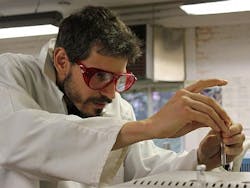Intelligence experts seek to identify people involved with chemical and biological weapons
Officials of the Intelligence Advanced Research Projects Agency (IARPA) in Washington have released a solicitation (IARPA-BAA-13-04) for the first phase of the Bio-Intelligence Chips (BIC) test & measurement program to help identify people who have been involved with chemical or biological weapons.
The Bio-Intelligence Chips Program (BIC) intends to develop new ways to test body fluids such as blood, urine, and saliva to determine if people have been handling agents involved with chemical or biological weapons production and handling. Analytics will be based on cross-correlating biomarkers in physiological fluids.
The initial part of the program focuses on identifying signatures that could be identified as sets of biomarkers that would point to a person's involvement in preparing or handing chemical or biological weapons.
These biomarkers should be identifiable in a human fluid sample as small as 100 microliters -- or just barely a trace. IARPA is the research arm of the Office of the Director of National Intelligence.
BIC performers will identify threat signatures in sets of biomarkers that would indicate contact with chemical or biological weapons involvement. IARPA experts are interested in developing tests that within 30 minutes or less than identify even tiny traces of chemical and biological weapons preparation and handling.
The human adaptive immune system is known to carry a long-term memory of the body‘s exposure to environmental irritants, chemical toxins, and biological antigens, IARPA researchers say. It is this long-term memory that the BIC program seeks to exploit. Immune memory can be extremely long-lived.
IARPA experts are interested in moving technology developed in the BIC program to a portable system that could be used in the field. Primary threats of interest are viruses, bacteria, bacterial poisons, and chemical poisons.
This solicitation involves the first two years of a potential five-year BIC program. The first phase involves identifying sets of omni-omic signatures for chemical or biological warfare threats of interest. Several contracts should be awarded for this phase.
The BIC program is interested in genomics, transcriptomics, proteomics, metabolomics, epigenomics, microbiomics, immunomics, glycomics, and lipodomics. The best known of these omics categories is genomics, which deals with bioinformatic data developed from the analysis of DNA sequences.
The other categories include:
-- transcriptomics, or the analysis of information derived from RNA transcription levels of expressed genes within a cell population;
-- proteomics, or the analysis of expressed proteins and their associated modifications;
-- metabolomics, or the analysis of levels of metabolites (small organic molecules, including regulatory peptides) associated with the maintenance of homeostasis;
-- epigenomics, or the study of heritable changes that are not directly encoded in DNA sequences;
-- microbiomics, or the analysis of the species, numbers, and locations of parasitic and commensal organisms, e.g., bacteria that live endosymbiotically with their hosts;
-- immunomics, or the analysis of information pertaining to changes in the immune system, particularly those associated with adaptive immunity;
-- glycomics, or the analysis of all glycan structures in an organism including the glycan's interaction with lectins and other biomolecules; and
-- lipodomics, or the analysis of pathways and networks of cellular lipids in biological systems, including the quantification of lipids, or the analysis of their conjugates (e.g., glycans) and their interactions with proteins, metabolites and other lipids.
Companies interested should respond no later than 29 Jan. 2014. For questions or concerns email IARPA's Dennis Polla, the BIC program manager, at [email protected].
More information is online at https://www.fbo.gov/notices/a77d9aee0f764559f0cb1ac071ebd98f.
